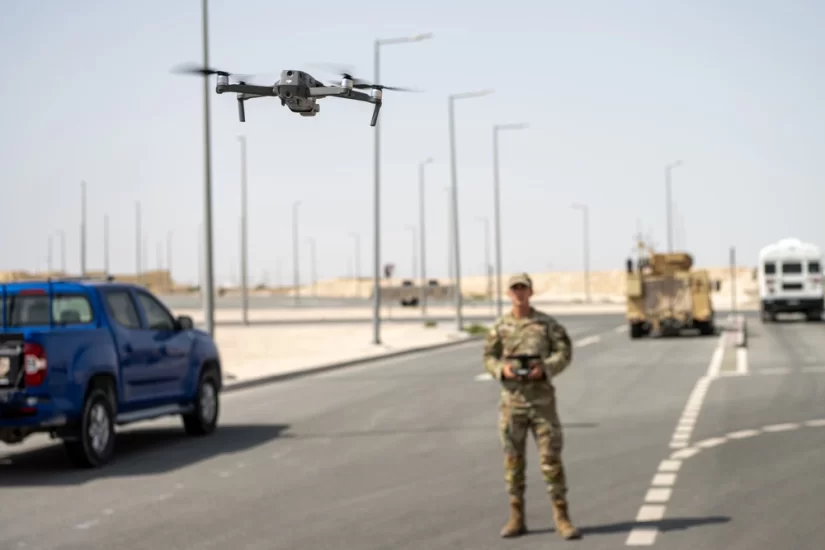The United States Department of Defense is seeking counter-small uncrewed aerial systems (C-sUAS) technologies for the Falcon Peak 2025.2 (FP25.2) discovery experiment later this year.
FP25.2 is planned from late July to early August at Peterson Space Force Base/Colorado Springs Municipal Airport and Fort Carson’s Pinon Canyon Maneuver Site. The event will provide a venue for participants to demonstrate their technologies in an operational environment by enabling them to operate their systems on a military installation to detect, track, identify, and defeat various Group 1 and 2 sUAS using LCD effects.
FP25.2 is intended to foster highly collaborative engagement with interested technology developers, with the dual objectives of providing the Department of Defense, civilian agencies, and the commercial marketplace new insight into promising C-sUAS detection technologies while enabling industry collaborators the opportunity to better understand the military installation Force Protection marketplace and evaluate their technology’s respective applicability.
North American Aerospace Defense Command and United States Northern Command (N&NC) will provide, operate, and deploy uncrewed platforms capable of addressing cross-domain and previously unseen threat profiles, including low-emission and no-emission (dark) UAS. FP25.2’s intent is to observe the readiness of commercially available systems, specifically those with a Technology Readiness Level (TRL) of 7, 8, and 9, employed as part of an overall effort to unify military base Force Protection measures falling under the purview of N&NC.
The following system capabilities are desired:
- Automatic detection of sUAS group 1 and group 2 categorized per Department of Defense Joint Publication 3-30 (Table 1). Detection of low-emission, non-emitting (dark), and 5G-cell enabled sUAS will be prioritised.
- Performance against multiple target aspects, course, speed, and altitude will be captured.
- Target signature thresholds shall be in accordance with the threat repositories maintained by the National Ground Intelligence Center, and National Air and Space Intelligence Center. Estimated signature threshold values available upon request to all industry partners who have access to SIPR or appropriate cage codes.
- Ability to detect, track, and identify multiple heterogeneous sUAS threats.
- LCD systems must demonstrate effective neutralisation (catastrophic defeat as defined by the recognisable system loss of control authority or the system’s immediate inability to maintain flight) of Group 1 and 2 sUAS threats under operational stress conditions for LCD-capable systems. LCD capabilities must prioritise precision mitigation with minimal collateral damage, environmental safety, and infrastructure protection. The systems should utilise high-precision technologies such as directed energy, high powered microwaves, or modular kinetic effectors to neutralise threats.
- Rapidly deployable (Fly Away) systems.
- Real time processing and display of detection, track, and identification information via local or distributed command systems.
- Sensors that are deployed/employed from a stationary site or structures, deployed in/on the ground or deployed/operated from a mobile platform such as a tethered balloon must be retrievable without alteration or damage to infrastructure and/or facilities.
- Sensors should maintain operational integrity in nearly all-weather conditions (-30°C to 50°C).
- Sensor data shall be capable of being reported to non-proprietary third-party Command and Control systems.
- Introduction of advanced C-sUAS capabilities including support for competitive engagement of targets with velocities ranging from 0 to 250 knots indicated airspeed (KIAS).
- For LCD capabilities, systems shall demonstrate a defeat capability on Groups 1 and 2 sUAS at 175 KIAS. Defeat is defined as the catastrophic defeat (recognisable system loss of control authority or the system’s immediate inability to maintain flight). Systems should pperate autonomously after issuance of launch command while employing C2 provisioned target state data as necessary.
- Data is required to be provided to the NORTHCOM data collection team in a .CSV or .XLSX format and is to include all tracking data in addition to system radar/EO/RF measurements (unfiltered, and track filtered as applicable) as well as applicable track covariance data.
FP25.2 will assess system technology readiness using direct measurement, when possible. This will include, but is not limited to, detection ranges, times, false contacts/alarms, track management, identification, collateral footprint, “cost per shot,” and track data.
In addition to a quantitative assessment of detection and tracking capability, other important considerations that will be assessed include installation and integration requirements; reliability, availability, and maintainability; tactical requirements; and a demonstrated ability to relocate and become operational.
N&NC will coordinate use of the test platforms and required integration for each selected technology. N&NC will also assist in identifying and integrating additional components required for sensor testing and assist with access, coordination, engineering, installation, interface with regulatory bodies, operation, test, and evaluation services.
Applications are invited by February 6. Respondents will be selected for FP25.2 based on readiness and ability to meet the objectives. FP25.2 is anticipated to last three weeks, with the first week being a set-up week.
Industry participation does not suggest or imply that the Department of Defense or any other US government activity will endorse, procure, or purchase equipment.
For more information
Department of Defense sources sought notice on SAM.gov
Image: US Air Force photo from a previous C-sUAS test event




